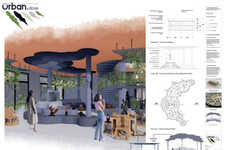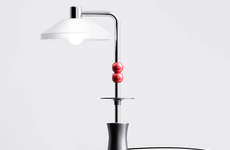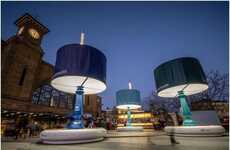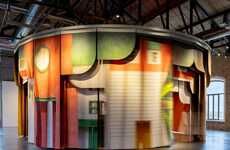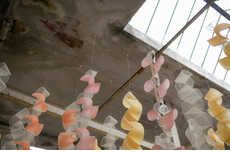
Emotional Cities
Bianca — January 5, 2008 — Art & Design
References: emotionalcities & emotionalcities
We've seen mood clothing and furniture, and now we can add emotion-sensitive architecture to that fascinating list thanks to incredible Swedish technology.
As part of the Emotional Cities project, the Haymarketscrapers in Stockholm change colour according to the feeling of the city's people. The city's five tallest skyscrapers act as colossal projections of the overall citizen mood. The scale ranges from depressed, which is reflected as deep purple, to happy, which is shown as vibrant red.
Tourists flying in will be able to tell the overall vibe of a city from the airplane window already, just by taking a peek at the towers!
So how do the moods of the people affect the towers? No surprise in today's wired world: with the help of citizen votes on the internet, of course. Stockholmers can log on to emotionalcities.com where they are greeting with, "How are you today?"
7 clickable circles appear below the question in all colours of the rainbow. The far left has the biggest frown on a violet sphere, next to it is indigo, then the expression gets happier as it progresses from light blue to green, yellow, orange and a happy red.
From there those who choose can keep a diary. Once answering "how," they have the opportunity to answer "why" in an online journal that can be kept entirely private.
The site also offers a chart of constantly updated city stats. A web cam can be seen here.
Rumor has it more cities will be getting mood lighting similar to emotional city including in South Korea.
As part of the Emotional Cities project, the Haymarketscrapers in Stockholm change colour according to the feeling of the city's people. The city's five tallest skyscrapers act as colossal projections of the overall citizen mood. The scale ranges from depressed, which is reflected as deep purple, to happy, which is shown as vibrant red.
Tourists flying in will be able to tell the overall vibe of a city from the airplane window already, just by taking a peek at the towers!
So how do the moods of the people affect the towers? No surprise in today's wired world: with the help of citizen votes on the internet, of course. Stockholmers can log on to emotionalcities.com where they are greeting with, "How are you today?"
7 clickable circles appear below the question in all colours of the rainbow. The far left has the biggest frown on a violet sphere, next to it is indigo, then the expression gets happier as it progresses from light blue to green, yellow, orange and a happy red.
From there those who choose can keep a diary. Once answering "how," they have the opportunity to answer "why" in an online journal that can be kept entirely private.
The site also offers a chart of constantly updated city stats. A web cam can be seen here.
Rumor has it more cities will be getting mood lighting similar to emotional city including in South Korea.
Trend Themes
1. Emotion-sensitive Architecture - Mood-sensitive architecture is breaking into the industry, creating disruptive innovation opportunities for architects to add more emotional design elements to buildings and public spaces.
2. Citizen Mood Analysis - Online tools and platforms can be developed to help collect and analyze data on citizen moods, creating disruptive innovation opportunities for tech companies to enhance predictive analytics.
3. Mood-influenced City Development - More cities may start using mood lighting and other design elements that reflect the overall mood of its inhabitants, providing disruptive innovation opportunities for city planners to create more emotionally engaging environments.
Industry Implications
1. Architecture - Mood-sensitive architecture is disrupting the architecture industry by introducing a new dimension to the traditional design process.
2. Technology - Advancements in technology have enabled the development of emotion-sensitive architecture and online tools for data collection and analysis, disrupting the tech industry and creating new business opportunities.
3. City Planning - The emotional impact of design and architecture on citizens is gaining importance in the city planning industry, creating disruptive innovation opportunities for more emotionally engaging urban landscapes.
2.9
Score
Popularity
Activity
Freshness



